-

人教版高中英语必修4Theme parks说课稿3篇
The oldest and the most popular park in the worldenjoy the exciting activities thereget close to the life-size cartoon characters like Mickey Mouse and Donald Duck Step 3 Pre-reading1.What do you suppose a theme park is ?2.What do you think you can see in a theme park?(1.It is a kind of amusement park which has a certain theme – that the whole park is based on. 2.buildings, castles, statues, rare animals and birds, and so on.) Step 4 Reading ----- Theme Parks –---- Fun and More Than Fun1.Predict : Read the title and the pictures on P. 34 and PredictWhat is the meaning of the title “Theme Park – Fun and more than fun”?(The title means that theme parks are fun to visit, but that they can also be educational and can offer useful information.)2.Skimming Fast read and answer:What activities can we take in a theme park?Amusement park: Bumper car Merry-go-round slide bungee jumping Free-fall rides Horror films Pirate ship Ferris wheel roller coaster3.Scanning Read again and you will find various theme parks are mentioned in the passage . Then what are they ?Theme parks: Sports theme park History theme park Culture theme park Marine or Ocean theme Park Future park Science theme park Disneyland4.Careful reading and find the main idea of each paragraph:THEME PARKS---- entertaining/ educationalPara.1 Traditional parks are places to go for relaxation and to have time away from our busy lives.Para.2 Theme parks are different They’re large and full of things to do, see and buy.Para.3 Theme parks are built around a single idea or theme. One example is a sports park.Para.4 Another kind of theme park is historical more and cultural and can be educational.Para.5 Disneylandwas the first theme park. It is based on the fantasy life and characters of Disney’s films.Para.6 Some examples of educational theme parks include sea world parks and science parks.

人教版高中英语必修3Healthy Eating说课稿4篇
Language learning needs a context, which can help the learners to understand the language and then can product comprehensible output, so computer has the advantages to make the materials attractive.Part 3 Learning MethodsTask-based, self-dependent and cooperative learningPart 4 Teaching ProcedureStep One Lead-in“Interest is the best teacher.” Therefore, at the very beginning of the class, I should spark the students’ mind to focus on the centre topic “the band”. I’ll show some pictures of food to attract their attention and then bring some questions.Question:What kind of food they like?What should go into a good meal?The answers must relate to the diet. After this, the students will be eager to know something about a balance diet and this is the very time to naturally lead the class into Step 2Step 2 Reading for information: skimming and scanning In this step, I use Task-based Language Teaching method, which can give students a clear and specific purpose while skimming and scanning the context.Task 1 General ideaThe students will be asked to just glance at the title and the pictures of the passage, and then guess what they will read in the text. And they’ll be divided into groups of four to have a discussion.The purpose is to inspire the students to read actively, not passively. In addition, the task is to develop the students’ reading skill by making prediction and to encourage the students to express their thoughts in English and cooperate with each other.Task 2 Main idea of each paragraphCooperative learning can raise the students’ interest and create an atmosphere of achievement. Based on this theory, I divide the whole class into 4 groups to skim the whole text and get the main idea of each paragraph.

人教版高中英语必修4Working The Land说课稿3篇
Knowledge objectives:(1) to make Ss grasp the usage of words, expressions and sentence structures: statistics, struggle, thanks to, rid of, some patterns for persuasion, the “ing” form as subject and object;(2)to use learnt knowledge to persuade sb.Ability objectives:(1) to develop Ss’ reading skills(skimming, scanning, word guessing);(2) to improve Ss’ speaking, communicating and cooperating skills.Emotional objectives:to make Ss know the contribution of Yuan,and learn his spirit and his simple life time.Teaching important and difficult points:(1) some words, expressions and sentence structures mentioned above;(2)the content of the text;(3)training their reading and speaking skills.Teaching methods: CLT, TBLT,QT.Learning strategies: CLS, QLS, TBLS.Teaching procedures:Step 1 lead-in: (1) teacher plays a piece of recent news from CCTV about the harvest of the super hybrid rice, and ask students whether they know Yuan or not, and talk about him and his contribution.(2)Brain storm: let Ss describe Yuan in their minds including his appearance, his living condition and so on.Step 2 fast reading tasks:(1)teacher introduces Yuan and super hybrid rice(2)make Ss read the text as fast as possible with questions. Such as: what’s the general ideaof this passage? What’s Yuan’ dream? (skimming and scanning skill)Step 3 intensive reading tasks(1)let Ss read the text silently, find topic sentence of each paragraph and draw the difficult sentences and the knowledge what they don’t understand.(words guessing)(2)teacher and Ss talk about the important words, expressions and sentences together, and ask Ss to retell the content of the text.(summarizing and paraphrasing)(3)teacher summarize this part.(4) read again following the courseware.

人教版高中英语必修3The million pound bank note说课稿3篇
在接下来的细读环节,我套用了高考对阅读理解的考查方式设置了5个问题,分别为三个推理判断题,一个细节题和一个主旨大意题。学生需要对文章的内容进行分析、归纳、推理、猜测等高级思维活动才能做出正确的回答。【设计意图】这一过程是对学生进行细读的训练,培养学生获取特定信息和挖掘文章深层次信息的能力。第三环节:Intensive-reading (精读) 15′第三个环节精读,既是最重要的环节,也是突破本课重难点的关键。首先,让学生思考剧本中人物看到百万英镑前后的态度发生了怎样的变化。其次,让学生仔细阅读文章,找出可以表现人物态度变化的具体的语言和动作。最后,让学生总结人物的态度发生变化的根本原因是什么,从而引出Money Talks, 供学生思考。【设计意图】通过一系列的活动培养学生学习从人物的语言和动作探究人物的心理,使学生进一步体会戏剧语言的魅力,从而对文章背后所反映的社会问题进行思考,也为下一步的讨论环节做好铺垫。

人教版高中英语必修5First aid说课稿6篇
In this class, I have 3 teaching aims, that is, knowledge aims, ability aims and emotion aims.1) Knowledge-Teach students new words and expressions, such as temporary, bleed,sprain choke, first aid, fall ill and so on.-Enable students to have a better understanding for some basic knowledge of first aid.2) Ability-Train students’ speaking, reading and writing abilities by different teaching activities, such as skimming, comprehending, team work, role play, retelling and writing.-Develop students’ reading strategy on how to move general idea to specific information.3) Emotion-Promote students’ awareness of giving first aid.- Cultivate students’ creativities.Then let’s come to my teaching methods and activities.III. Teaching methods and activities:To achieve different teaching aims, various kinds of teaching methods and activities will be adopted throughout this period, such as TBL (task-based learning), skimming, team work, brainstorm and others, which can offer students opportunities to fulfill tasks in which they can use language to achieve a specific outcome.IV. Teaching aids:Computer and blackboardV. Teaching important points:1) Make students have a clear mind for the structure of the text.2) Help students understand the theme of the text.VI. Teaching difficulties:1) So many new words may affect students’ understanding.2) How to get students to know about the functions of the skin and thecauses, characteristics and treatments for different degree burns,and the knowledge about giving first aid. VII. Blackboard design:

人教版高中英语必修5Life in the Future说课稿5篇
Good afternoon, everyone. It’s my great pleasure to be here sharing my lesson with you. The content of my lesson is Senior English for China Book5 Unit 3 Life in the Future. I’ll be ready to begin this lesson from six parts: Analysis of the teaching material, Analysis of the students, Teaching aims and important and difficult points, Teaching methods and aids, Teaching procedures, and Blackboard design. First, let me talk about the teaching material.Part 1 Analysis of the Teaching Material:This unit is about what human beings’ life will be like in about one thousand years. By studying of this unit, we’ll Enable the students to know the changes in humans’ life and some new inventions bringing about the change and develop the interest in science. This lesson plays an important part in the English teaching in this unit. This is an important lesson in Book Five. From this lesson, it starts asking the Ss to grasp contents of each passage. Therefore, this lesson is in the important position of the teaching material. If the Ss can learn it well, it will be helpful to make the Ss learn the rest of this unit.Part 2 Analysis of the SsAs Senior2 Ss, they are at different levels of English fluency, some of them have lost interest in English. So during the lesson, I arrange a variety of activities to let all of them join in to attract their interest and let them be confident and taste the joy of success.

人教版高中英语必修5Making the news说课稿4篇
今天我们来介绍一下必修五第四单元的授课方式。这个单元的题目是Making the news。应该是学生比较感兴趣的话题,学生往往对新闻工作充满好奇,所以我们可以利用这个机会多设计一些师生互动和学生互动,来激发起学习的积极性,提高学习效率。同时我们可以利用这个单元不仅帮助学生掌握语言知识,培养语言能力,同时让其了解新闻工作的重要性,培养起社会智能感。这个单元分为六个课时,它的教学目标是这样的:语言目标是掌握词汇表中的常用单词和短语,掌握倒装句的一些基本用法。 技能目标是能初步掌握约会的基本句型并在真实的场景下正确运用。新闻报道类文章的写作技能。采访的基本规范和沟通技能。情感目标是对新闻报道的客观性和真实性有更好的理解。对新闻记者的职业有更深入的了解,并能体会其工作的重要性。下面我们来介绍一下第一课时的授课方式,第一课的教学目标是这样的第一课时的教学目标语言目标:单词:Occupation, journalist, editor, photographer, curious, personality, enthusiasm

人教版高中英语必修5The United Kingdom说课稿4篇
Teaching Aims:Knowledge 1. Get the students to learn the useful new words and expressions in this section. Aims:2. Let the students learn about how the UK was formed and the four groups of invaders.1. Develop students’ reading ability and let them learn different Ability reading skills. Aims:2. Enable students to learn to talk about the United Kingdom and the Union Jack Emotional 1. Let students know more about the UK2. Develop students’ sense of cooperative learning Aims:Teaching Important Points:1. Let the students learn about the countries of the United Kingdom and the Union Jack2. Get the students to read the passage and know about how the UK was formed and the four groups of invaders.3. Have the students learn different reading skills.Teaching Difficult Ponts:1. Develop students’ reading ability.2. Enable students to talk about the United Kingdom and the Union Jack.3. Let students learn how the UK was formed geographically and historically.Teaching Methods:Showing pictures, asking, exercising, listening, reading etc.Teaching Aids:A computer,a projector and a blackboard.Teaching Procedures: 1) Show a map of the world, ask students the following questions:Where is the UK?What’s the full name of the UK?2) Ask the students work in pairs to do the quiz on Page 9.Do you want to test how many things you know about the United Kingdom? Let’s have a small test.Using the map on P9, students answer the following questions:?How many countries does the UK consist of? What are they??England is divided into three main areas. Do you know what they are? 1) Scanning (10Minutes )Let the students hold the questions asked in pre-reading and read the passagequickly and then let them do the following exercise.Join lines to the right answer.

人教版高中地理必修2煤城焦作出路何在说课稿
分析过焦作市的地理概况和产业优势后,就需要针对由于资源枯竭所带来的问题提出合理化的建议。既然是谈经济转型,就应该将话题的范围明确在这一领域内。通过材料3的相关内容,我们了解到焦作市需要在产业结构调整、培育新的优势产业、增强综合竞争力等三个整改方针上下功夫。因而引导学生针对优势与不足提出建议,以三个整改方针为基准,衡量建议的可行性是锻炼学生解决此类问题的有效途径。在此我将教会学生的是解决问题方法而非案例的内容,正所谓“授之以鱼,不如授之以渔”。接下来针对学生的建议和教材资料分析所罗列的10点整改思路,由学生自由发言提出看法,通过教师的指导和学生的讨论,进而确定经济转型建议的具体方案。最后注意将建议与产业优势相对照,看建议是否都是围绕着产业优势而提出的,这样做会加深学生的印象,通过建议和优势的对应关系,将不难找出此类问题的解题思路。
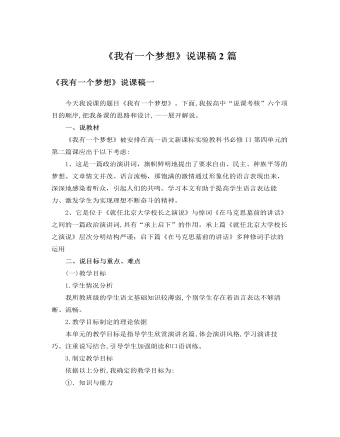
人教版高中语文必修2《我有一个梦想》说课稿2篇
(2).教学手段为了使我根据教材而设计的三个教学目标以及重点难点得以的突出和突破,达到最大化的展示境界,同时也为了配合以上我选择的四种教法得以完满实现,我决定采用“多媒体”教学手段进行全程教学。利用电脑的信息容量大,操作简便等优点,形象生动的直观展示教学内容,不但提高学习效率和质量,而且容易激发学生的学习兴趣和调动学习的积极性。四、说学法我为学生设计了三个学习方法:1.让学生学会在探究中学。通过“对黑人严酷处境的探究”和对文中重点语句的探究,培养学生在探究中学习的能力。2.让学生学会在读中学。通过“诵读法”指导学生在诵读过程中感受演讲词内在的魅力,学会在读中学。3.让学生学会在练习中学。通过“课外延伸练习法”,对所学的知识进行运用,培养学生的创新和自学能力。
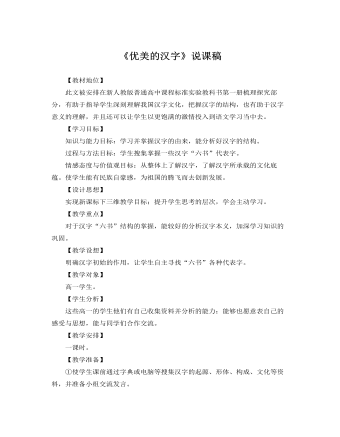
人教版高中语文必修1《优美的汉字》说课稿
明确:(1)结绳记事说。原始记事的一种方法。人类在没有发明文字或文字使用尚不普遍时,常用在绳索或类似物件上打结的方法记录数字,表达某种意思,用以传达信息,处理事件。 (2)书画说。(3)仓颉造字说。中国自古就有仓颉造字之说。文字的发明是人类发展史上一件石破天惊的大事,它将人们的思维、语言、经验以及复杂的社会现象记录下来,使文化得以传播交流、世代传承。2、汉字的形体:中华民族五千年的历史中,汉字的演变,从甲骨文--金文--大篆--小篆--隶书--草书--楷书--行书,字形由象形到点横竖撇捺的方块字,经历了漫长的岁月。其中凝聚着民族的智慧,也体现出汉字逐步完善的过程,凸显其方方正正、四平八稳的特点。汉字又是一种文化的体现,那些经过艺术处理的汉字或跳起了拉丁舞、有的如同酒醉的成龙打起了醉拳,更是让我们感到的是在欣赏汉字在纸张上跳舞,所以:书法是“纸上的舞蹈”。请大家看到书上的相关内容,注意每一种形体的汉字的载体是什么,其功能又有什么不一样。
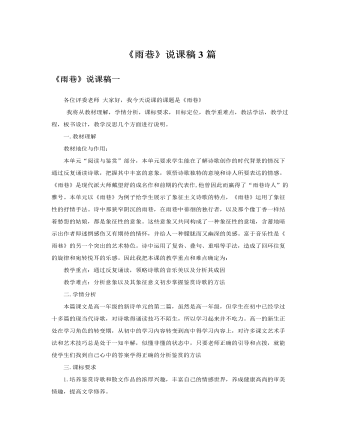
人教版高中语文必修1《雨巷》说课稿3篇
一.教材理解教材地位与作用:本单元“阅读与鉴赏”部分,本单元要求学生能在了解诗歌创作的时代背景的情况下通过反复诵读诗歌,把握其中丰富的意象,领悟诗歌独特的意境和诗人所要表达的情感。《雨巷》是现代派大师戴望舒的成名作和前期的代表作,他曾因此而赢得了“雨巷诗人”的雅号。本单元以《雨巷》为例子给学生展示了象征主义诗歌的特点,《雨巷》运用了象征性的抒情手法。诗中那狭窄阴沉的雨巷,在雨巷中徘徊的独行者,以及那个像丁香一样结着愁怨的姑娘,都是象征性的意象。这些意象又共同构成了一种象征性的意境,含蓄地暗示出作者即迷惘感伤又有期待的情怀,并给人一种朦胧而又幽深的美感。富于音乐性是《雨巷》的另一个突出的艺术特色。诗中运用了复沓、叠句、重唱等手法,造成了回环往复的旋律和宛转悦耳的乐感。因此我把本课的教学重点和难点确定为:教学重点:通过反复诵读,领略诗歌的音乐美以及分析其成因教学难点:分析意象以及其象征意义初步掌握鉴赏诗歌的方法
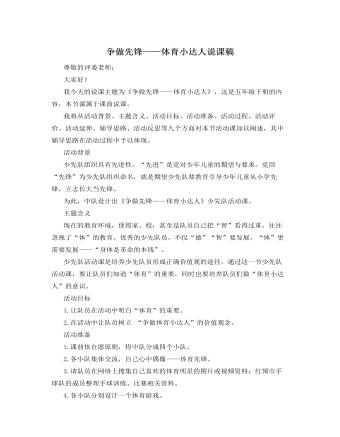
《争做先锋——体育小达人》说课稿
《少先队活动课指导纲要》明确指出,要通过颁授“雏鹰奖章”,促进全面发展的成效进行评价,及时进行过程性评价激励。本节活动课,在评价环节设置了队员对队员的评价,小队间的评价,颁发“先锋章”的评价,符合《纲要》精神。活动延伸1.课后,将小队设计的体育游戏向别的小队、中队辐射;并鼓励其他小队、中队设计具有自身特色的体育游戏。2.搜集整理有关“行为习惯”资料,为下节课“争做先锋——文明小达人”做准备。活动反思1.少先队活动课应该培养队员掌控课堂的能力,以及学会处理课堂上一些突发情况的能力。虽说是五年级的队员,但辅导员老师还是应在课前进行培训。2. 活动课主题的选择,应从队员生活实际出发,从队员兴趣出发,引导队员积极参与。3.队课要向队员灌输正确的观念,本节活动课“争做先锋——体育小达人”符合这个要求。

中班听说《猜莲子》说课稿
(一)游戏导入。在这个活动的开始,老师和孩子们围坐成半圆形,这样就自然地缩短了老师和孩子们之间的距离,孩子们会觉得老师很亲近自己,为游戏情景的设置打好了情感基础。接着,老师出示莲蓬剥出莲子“这是什么呢?对,莲子。我们要在池塘里种上莲子,明年才能结出莲蓬。今天,请小朋友扮演池塘里的泥,老师把这颗莲子种到池塘里,大家一起玩一个种莲子的游戏。”良好的游戏情景自然的设置好了,这也是激发孩子们参与的兴趣、集中孩子们注意力的一种很好的策略。(二)交代游戏规则及玩法。游戏规则有以下几点:1、扮泥的小朋友必须将眼睛闭起来,不能偷看,等儿歌念完后才能睁开。2、种莲子的人会在儿歌结束前将莲子放在一个小朋友的手里,并且用简短的语言来描述这个小朋友的外貌特征,请大家来猜。3、被猜出的小朋友必须重复说出自己的外貌特征。
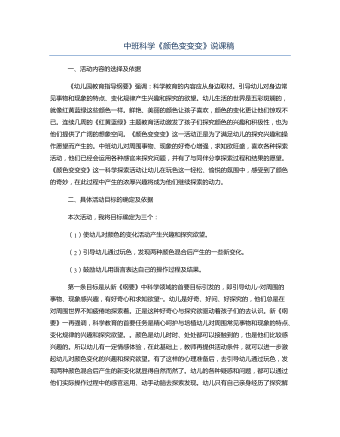
中班科学《颜色变变变》说课稿
《幼儿园教育指导纲要》强调:科学教育的内容应从身边取材。引导幼儿对身边常见事物和现象的特点、变化规律产生兴趣和探究的欲望。幼儿生活的世界是五彩斑斓的,就像红黄蓝绿这些颜色一样。鲜艳、美丽的颜色让孩子喜欢,颜色的变化更让他们惊叹不已。连续几周的《红黄蓝绿》主题教育活动激发了孩子们探究颜色的兴趣和积极性,也为他们提供了广阔的想象空间。《颜色变变变》这一活动正是为了满足幼儿的探究兴趣和操作愿望而产生的。中班幼儿对周围事物、现象的好奇心增强,求知欲旺盛,喜欢各种探索活动,他们已经会运用各种感官来探究问题,并有了与同伴分享探索过程和结果的愿望。《颜色变变变》这一科学探索活动让幼儿在玩色这一轻松、愉悦的氛围中,感受到了颜色的奇妙,在此过程中产生的浓厚兴趣将成为他们继续探索的动力。
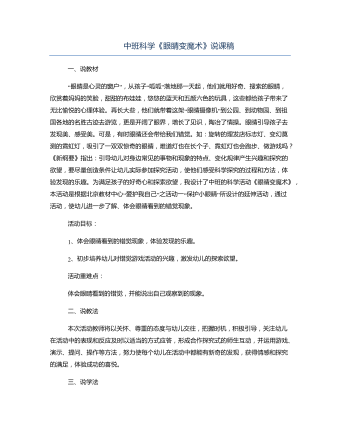
中班科学《眼睛变魔术》说课稿
“眼睛是心灵的窗户”,从孩子“呱呱”落地那一天起,他们就用好奇、搜索的眼睛,欣赏着妈妈的笑脸,甜甜的布娃娃,悠悠的蓝天和五颜六色的玩具,这些都给孩子带来了无比愉悦的心理体验。再长大些,他们就带着这架“眼睛摄像机”到公园、到动物园、到祖国各地的名胜古迹去游览,更是开阔了眼界,增长了见识,陶冶了情操。眼睛引导孩子去发现美、感受美。可是,有时眼睛还会带给我们错觉。如:旋转的理发店标志灯、变幻莫测的霓虹灯,吸引了一双双惊奇的眼睛,难道灯也在长个子、霓虹灯也会跑步、做游戏吗?《新纲要》指出:引导幼儿对身边常见的事物和现象的特点、变化规律产生兴趣和探究的欲望,要尽量创造条件让幼儿实际参加探究活动,使他们感受科学探究的过程和方法,体验发现的乐趣。为满足孩子的好奇心和探索欲望,我设计了中班的科学活动《眼睛变魔术》,本活动是根据北京教材中心“爱护我自己”之活动一“保护小眼睛”所设计的延伸活动,通过活动,使幼儿进一步了解、体会眼睛看到的错觉现象。
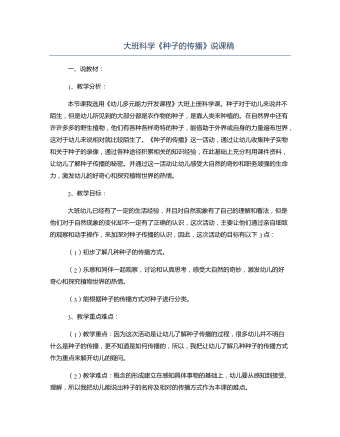
大班科学《种子的传播》说课稿
本节课我选用《幼儿多元能力开发课程》大班上册科学课。种子对于幼儿来说并不陌生,但是幼儿所见到的大部分都是农作物的种子,是靠人类来种植的。在自然界中还有许许多多的野生植物,他们有各种各样奇特的种子,能借助于外界或自身的力量遍布世界,这对于幼儿来说相对就比较陌生了。《种子的传播》这一活动,通过让幼儿收集种子实物和关于种子的录像,通过各种途径积累相关的知识经验,在此基础上充分利用课件资料,让幼儿了解种子传播的秘密。并通过这一活动让幼儿感受大自然的奇妙和职务顽强的生命力,激发幼儿的好奇心和探究植物世界的热情。大班幼儿已经有了一定的生活经验,并且对自然现象有了自己的理解和看法,但是他们对于自然现象的变化却不一定有了正确的认识,这次活动,主要让他们通过亲自细致的观察和动手操作,来加深对种子传播的认识,因此,这次活动的目标有以下3点:(1)初步了解几种种子的传播方式。(2)乐意和同伴一起观察,讨论和认真思考,感受大自然的奇妙,激发幼儿的好奇心和探究植物世界的热情。(3)能根据种子的传播方式对种子进行分类。
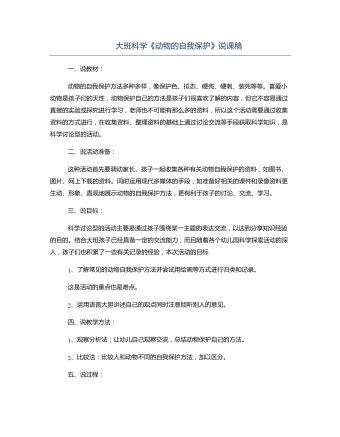
大班科学《动物的自我保护》说课稿
动物的自我保护方法多种多样,像保护色、拟态、硬壳、硬刺、装死等等。喜爱小动物是孩子们的天性,动物保护自己的方法是孩子们很喜欢了解的内容,但它不容易通过直接的实验或探究进行学习,老师也不可能有那么多的资料,所以这个活动需要通过收集资料的方式进行,在收集资料、整理资料的基础上通过讨论交流等手段获取科学知识,是科学讨论型的活动。这种活动首先要调动家长、孩子一起收集各种有关动物自我保护的资料,如图书、图片、网上下载的资料。同时运用现代多媒体的手段,如准备好相关的课件和录像资料更生动、形象、直观地展示动物的自我保护方法,更有利于孩子的讨论、交流、学习。
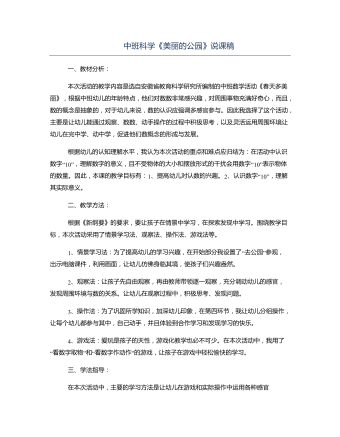
中班科学《美丽的公园》说课稿
本次活动的教学内容是选自安徽省教育科学研究所编制的中班数学活动《春天多美丽》,根据中班幼儿的年龄特点,他们对数数非常感兴趣,对周围事物充满好奇心,而且,数的概念是抽象的,对于幼儿来说,数的认识应强调多感官参与。因此我选择了这个活动,主要是让幼儿能通过观察、数数、动手操作的过程中积极思考,以及灵活运用周围环境让幼儿在完中学、动中学,促进他们数概念的形成与发展。根据幼儿的认知理解水平,我认为本次活动的重点和难点应归结为:在活动中认识数字“10”,理解数字的意义,且不受物体的大小和摆放形式的干扰会用数字“10”表示物体的数量。因此,本课的教学目标有:1、提高幼儿对认数的兴趣。2、认识数字“10”,理解其实际意义。
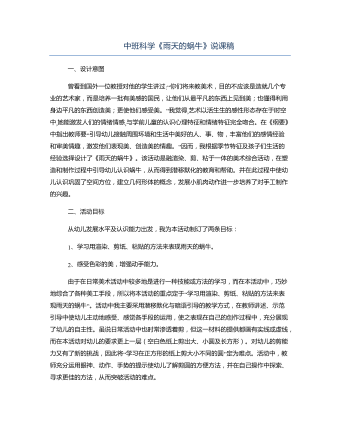
中班科学《雨天的蜗牛》说课稿
曾看到国外一位教授对他的学生讲过:“你们将来教美术,目的不应该是造就几个专业的艺术家,而是培养一批有美感的国民,让他们从最平凡的东西上见到美;也懂得利用身边平凡的东西创造美;更使他们感受美。”我觉得,艺术以活生生的感性形态存在于时空中,她能激发人们的情绪情感,与学前儿童的认识心理特征和情绪特征完全吻合。在《纲要》中指出教师要“引导幼儿接触周围环境和生活中美好的人、事、物,丰富他们的感情经验和审美情趣,激发他们表现美、创造美的情趣。”因而,我根据季节特征及孩子们生活的经验选择设计了《雨天的蜗牛》。该活动是融渲染、剪、粘于一体的美术综合活动,在塑造和制作过程中引导幼儿认识蜗牛,从而得到潜移默化的教育和帮助。并在此过程中使幼儿认识巩固了空间方位,建立几何形体的概念,发展小肌肉动作进一步培养了对手工制作的兴趣。


